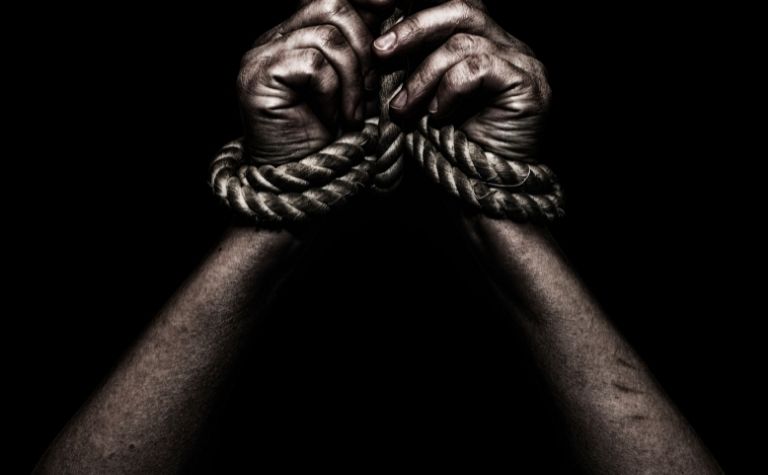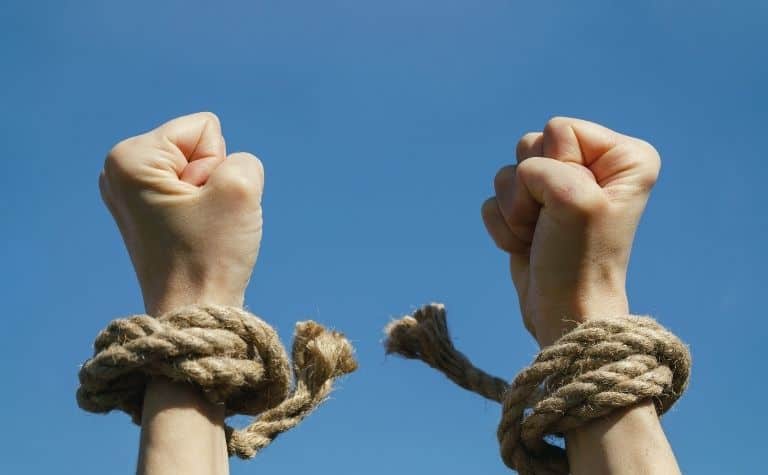In the grand scheme of human history, two and a half centuries is a relatively short period. Within this timeframe, the Vikings accumulated great wealth, conquered new territories, and explored distant lands.
Even so, they did not accomplish these achievements by themselves.
The Vikings had help from the social class known as the thrall in Old Norse, known to everybody else as slaves.
The Vikings had slaves, and they also engaged in the slave trade.
Through the numerous raids they staged in the British Isles and parts of Europe, the Vikings took many civilians and opposing forces captive, enslaving and trafficking them.
The Vikings even took fellow Scandinavians as slaves.
The Vikings were not alone in owning or trading slaves in Medieval Europe. But they engaged in human trafficking on an unprecedented scale for the time period.
It is becoming more apparent that much of the power they achieved during the Viking Age is owed to their use of slaves as a labor force and the revenue they generated trading them.
Here is a glimpse into just how much of a difference this practice made.
Keep reading to learn more.
Also see Why Did the Vikings Say Skol? to learn more.

Who Were the Vikings’ Slaves?
At the early stages of the Viking Age, the nations of Norway, Sweden, and Denmark, as we know them today, did not exist, and kingdoms unified under a single ruler did not come about until later.
Across Scandinavia, Norse society was divided into three general classes:
- The jarls comprised the noble class and were made up primarily of wealthy landowners and powerful chieftains
- The karls were freemen and made up the broad middle class from which farmers, warriors, and the like all hailed
- The thralls were the lowest social class in Viking society and were slaves with no rights or freedoms, legal or otherwise [1]
Although particular circumstances could vary from person to person, there were three basic ways that someone became a slave during the Viking Age:
- By birth – one of the realities of slavery was that its ranks grew as slaves bore children who were destined to the same lot in life as their parents
- By capture – as the Vikings laid siege to regions throughout Northern Europe, they enslaved local populations as well as opposing forces who survived the initial onslaught only to have their freedom taken away from them
- By default – Vikings who became overly indebted could, in essence, barter their freedom for the absolution of debts, and there were those that chose this path however extreme the consequences may seem (certain offenses could also be punishable by a term of enslavement) [2]
The Vikings burst onto the world scene largely as a result of their daring and nearly indefensible raids.
But these attacks were not limited to foreign lands.
Quite often, the Vikings raided each other as Scandinavia during the Middle Ages was nothing more than a loose patchwork of rival chieftains and warlords.
As a result, many Viking slaves were actually native Scandinavians. [3] (Also see Did the Vikings Have Cats?)
As far as people enslaved from areas outside of Scandinavia, they were likely citizens captured as part of the spoils from raiding a particular area or prisoners of war.
As far as nationalities or ethnicities, these slaves were primarily:
- Irish
- British
- Frankish (from areas now comprising modern-day France, Belgium, and western Germany)
- Slavic (today, these would be people from Russia, Ukraine, and Belarus) [4]
Also see What Kind of Bows Did the Vikings Use? to learn more.

How Many Slaves Did Vikings Have?
As the Vikings did not record their own written history, scholars have been left with the arduous task of reconstructing various aspects of their lives, including the apparently significant role that slavery played in their society.
Archaeological evidence has been scant at best, but historians are turning to other ways to answer questions like how many slaves the Vikings had.
It is settled that the Vikings not only had slaves but also traded them as chattel.
Eyewitness and third-party accounts describe what essentially amounted to mass kidnappings of men, women, and even children, during Viking raids throughout Europe.
While it is difficult to pin an exact, or even an approximate number, of slaves at the peak of Viking human trafficking activities, there are indications:
- The Middle Age Irish journal, The Annals of Ulster, describes the sacking of a local town and the taking of great numbers of local women, while other accounts throughout the Viking Age lend support to the notion that thousands upon thousands of people were enslaved by the Vikings [5]
- The Vikings are known to have enslaved thousands of women from Ireland and Scotland and taken them to their settlements in Iceland [6]
By one approximation, an estimated ten percent of the entire population of Viking Scandinavia (an area comprising the modern nations of Norway, Sweden, and Denmark) may have been slaves. [7]
To put this into perspective, modern-day scholars believe that the combined population of these Scandinavian areas during the Viking Age was about 1,000,000 people. [8]
At a ten percent clip, this equates to roughly 100,000 slaves, which is an astonishing number given the period and demonstrates how significant of a role slavery played in Viking society at the height of their influence.
In fact, there may very well be a direct correlation between the two; in other words, the widespread practice of slavery contributed greatly to the Vikings’ wealth and power. (Also see 10 Famous Vikings from History)
Also see What Language Did the Vikings Speak? to learn more.
What Did Viking Slaves Do?
As lucrative as slave trading was for the Vikings during the Middle Ages, their slaves comprised a faceless workforce without whose insufferable, back-breaking labor, the great achievements of the Vikings would never have been.
As historians are learning, the most difficult and undignified tasks were reserved for Viking slaves to perform. [9]
For male slaves, most of these duties centered around the farm:
- Herding livestock such as cattle, pigs, and sheep, was a common task for male Viking slaves
- Fertilizing fields with animal dung
- Harvesting hay and other crops
- Cutting out chunks of turf from the ground
- Other tasks including hunting, fishing, and forest work
Female Viking slaves had their own set of chores around the farm and homestead, including difficult jobs like:
- Milking cows (a particularly undesirable task during the Viking Age)
- Grinding grain by hand using two large stones (known as a quern)
- Preparing meals for an entire homestead
- Caring for the children of the household
Scholars believe that the Vikings needed vast numbers of slaves to support the construction of one of their most iconic implements: the Viking longships. [10]
As they ventured further out from their native Scandinavia to conquer new territories and reach trade destinations, the Vikings had a great need for more vessels for ferrying warriors and transporting goods. To illustrate the need for a large labor force:
- Each Viking ship had two large sails, which were fabricated from wool
- It is estimated that a single person could produce a 90-square-foot sail in no less than five years
- Hundreds (if not thousands) of vessels would have been needed throughout the Viking Age to support the numerous raids and commercial voyages
There would have been numerous support industries for shipbuilding, such as:
- Raising sheep to produce the wool needed for the sails
- Harvesting trees to produce the lumber for building the ships
It becomes clear that extensive slave labor was used to put Viking ships on the seas of the North Atlantic and surrounding waterways.
Did the Vikings Free Their Slaves?
In the plainest of terms, slaves were a valuable commodity for the Vikings.
Not only did they provide invaluable labor performing the most difficult and undesirable of tasks, but they also represented tremendous trade value.
Slavery was a highly lucrative business for the Vikings. As such, there was very little incentive for the Vikings to simply let any of their slaves go free without receiving anything in return.
The fact that the offspring of slaves were born into slavery and that there were many multi-generational (i.e., 2nd and 3rd-generation slaves, and so on) thralls is a strong indication that the vast majority of slaves lived and died as thralls.
However, this is not to say that slavery was absolute. There were instances where slaves obtained their freedom or at least some semblance of it:
- Although the general rule was that Viking slaves “could own nothing, inherit nothing, leave nothing,” in rare cases, a thrall would be permitted to keep a small percentage of the revenue made from selling goods at market on their owner’s behalf and thereby be in a position to purchase their freedom [11]
- There are also historical accounts describing the purchase of slaves by an individual for the specific purpose of setting them free, as exemplified by a monk who sold all of his possessions in order to buy a group of enslaved Christians and restore them to a life of freedom (this particular instance was likely a case of one Christian looking out for other Christians) [12]
- There is evidence to support the notion that there were benevolent slave owners who granted a slave his or her freedom. One such case is of a former slave named Toki Smith, who erected a rune stone in honor of his former owner from whom he was granted “gold and freedom.” [13]
Final Thoughts
The Vikings have left an enduring legacy of far-reaching conquests, and it is becoming more apparent that slaves were a big part of that story.
References:
[1] Sources
[2] Sources
[3] Sources
[4] Sources
[5] Sources
[6] Sources
[7] Sources
[8] Sources
[9] Sources
[10] Sources
[11] Sources
[12] Sources
[13] Sources
